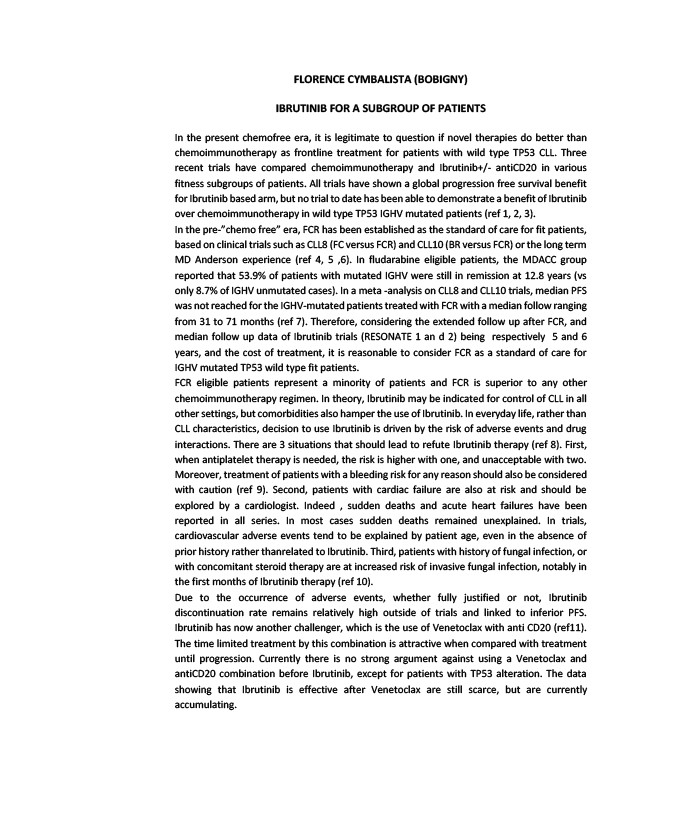
FLORENCE CYMBALISTA (BOBIGNY)
IBRUTINIB FOR A SUBGROUP OF PATIENTS
In the present chemofree era, it is legitimate to question if novel therapies do better than
chemoimmunotherapy as frontline treatment for patients with wild type TP53 CLL. Three
recent trials have compared chemoimmunotherapy and Ibrutinib+/- antiCD20 in various
fitness subgroups of patients. All trials have shown a global progression free survival benefit
for Ibrutinib based arm, but no trial to date has been able to demonstrate a benefit of Ibrutinib
over chemoimmunotherapy in wild type TP53 IGHV mutated patients (ref 1, 2, 3).
In the pre-”chemo free” era, FCR has been established as the standard of care for fit patients,
based on clinical trials such as CLL8 (FC versus FCR) and CLL10 (BR versus FCR) or the long term
MD Anderson experience (ref 4, 5 ,6). In fludarabine eligible patients, the MDACC group
reported that 53.9% of patients with mutated IGHV were still in remission at 12.8 years (vs
only 8.7% of IGHV unmutated cases). In a meta -analysis on CLL8 and CLL10 trials, median PFS
was not reached for the IGHV-mutated patients treated with FCR with a median follow ranging
from 31 to 71 months (ref 7). Therefore, considering the extended follow up after FCR, and
median follow up data of Ibrutinib trials (RESONATE 1 an d 2) being respectively 5 and 6
years, and the cost of treatment, it is reasonable to consider FCR as a standard of care for
IGHV mutated TP53 wild type fit patients.
FCR eligible patients represent a minority of patients and FCR is superior to any other
chemoimmunotherapy regimen. In theory, Ibrutinib may be indicated for control of CLL in all
other settings, but comorbidities also hamper the use of Ibrutinib. In everyday life, rather than
CLL characteristics, decision to use Ibrutinib is driven by the risk of adverse events and drug
interactions. There are 3 situations that should lead to refute Ibrutinib therapy (ref 8). First,
when antiplatelet therapy is needed, the risk is higher with one, and unacceptable with two.
Moreover, treatment of patients with a bleeding risk for any reason should also be considered
with caution (ref 9). Second, patients with cardiac failure are also at risk and should be
explored by a cardiologist. Indeed , sudden deaths and acute heart failures have been
reported in all series. In most cases sudden deaths remained unexplained. In trials,
cardiovascular adverse events tend to be explained by patient age, even in the absence of
prior history rather thanrelated to Ibrutinib. Third, patients with history of fungal infection, or
with concomitant steroid therapy are at increased risk of invasive fungal infection, notably in
the first months of Ibrutinib therapy (ref 10).
Due to the occurrence of adverse events, whether fully justified or not, Ibrutinib
discontinuation rate remains relatively high outside of trials and linked to inferior PFS.
Ibrutinib has now another challenger, which is the use of Venetoclax with anti CD20 (ref11).
The time limited treatment by this combination is attractive when compared with treatment
until progression. Currently there is no strong argument against using a Venetoclax and
antiCD20 combination before Ibrutinib, except for patients with TP53 alteration. The data
showing that Ibrutinib is effective after Venetoclax are still scarce, but are currently
accumulating.